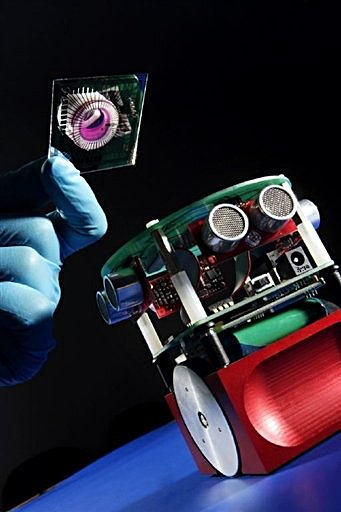Science Fiction
Dictionary
A B C D E F G H I J K L M N O P Q R S T U V W X Y Z
Rat Brain Robot Uses Cultured Rat Neurons

Cultured rat neurons placed on a multi-electrode array (MEA) form the brain of Gordon the robot. This brain is housed in a special temperature-controlled unit separate from the robot; Bluetooth is used for control signals.
The rat neurons life in a nutrient-rich medium kept at a constant temperature; they organize themselves within several weeks, organizing themselves based on electrical impulses received from sensors in the wheels.

(Meet Gordon, a rat neuron-controlled robot.)
"The purpose is to figure out how memories are actually stored in a biological brain," said Kevin Warwick, a professor at the University of Reading and one of the robot's principle architects."If we can understand some of the basics of what is going on in our little model brain, it could have enormous medical spinoffs."
(Gordon, a rat neuron-controlled robot video.)
Incredibly, different MEA-based brains show different personalities; Gordon has several 'spare' brains that can be plugged in.
"It's quite funny -- you get differences between the brains," said Warwick. "This one is a bit boisterous and active, while we know another is not going to do what we want it to."
Science fiction readers are thoroughly familiar with this idea; laminated mouse brains are used to pilot interstellar ships in the 1962 story Think Blue, Count Two by Cordwainer Smith.
See also Peter Watts' head cheese from his 1999 novel Starfish, which is a pretty exact match for Gordon's brain.
From Breitbart; thanks to Moira for prodding me into doing this story.
Scroll down for more stories in the same category. (Story submitted 8/15/2008)
Follow this kind of news @Technovelgy.| Email | RSS | Blog It | Stumble | del.icio.us | Digg | Reddit |
Would
you like to contribute a story tip?
It's easy:
Get the URL of the story, and the related sf author, and add
it here.
Comment/Join discussion ( 3 )
Related News Stories - (" Biology ")
Black Fungus Blocks Radiation
'You were surrounded by Astrophage most of the time' - Andy Weir, 2021.
Lunar Biorepository Proposed For Cryo-Preservation Of Earth Species
'...there was no one alive who had ever seen them. But they existed in the Life Bank.' - John Varley, 1977.
Let's Make Slaver Sunflowers! Engineering Plants To Reflect Light
'The mirror-blossom was a terrible weapon.' - Larry Niven, 1965.
Machete-Wielding Philodendron Isn't Going To Take It Anymore
'The tree ended its wild larruping, stood like a dreaming giant liable to wake into frenzy at any moment.' - Eric Frank Russell, 1943.
Technovelgy (that's tech-novel-gee!) is devoted to the creative science inventions and ideas of sf authors. Look for the Invention Category that interests you, the Glossary, the Invention Timeline, or see what's New.
Science Fiction
Timeline
1600-1899
1900-1939
1940's 1950's
1960's 1970's
1980's 1990's
2000's 2010's
Current News
Jetson ONE Air Races Begin, Can Air Polo Be Far Behind?
'If you're one of those rarities who haven't attended a rocket-polo "carnage", let me tell you it's a colorful affair.'
Will Space Stations Have Large Interior Spaces Again?
'They filed clumsily into the battleroom, like children in a swimming pool for the first time, clinging to the handholds along the side.'
Mornine Sales Robot
'Robot-salesmen were everywhere, gesturing...'
Bipedal Robot Floats Gently While Walking
'a walking balloon proceeded with long strides of its aluminum legs...'
Musk Idea Of Cars Talking To Each Other Predicted 70 Years Ago
'My cars talk to one another.'
Elegant Bivouac Shelter Produces Water And Electricity
'There was nowhere on the planet where science and technology could not provide one with a comfortable home...'
X-Control Janus-1 A Suitcase Aircraft
'You will notice that it... fits the suitcase nicely.'
'AI Assistants' Are Actually Less Reliable For News
'Most men updated their PIP on New Year's Day...'
YES!! Remote Teleoperated Robots predicted by Technovelgy!
'...a misshapen, many-tentacled thing about twice the size of a man.'
Will Robots Ever Fold Landry?
Where have you gone, Mrs. Robinson?
Will AIs Give Better Results If You're Rude To Them?
'I said, "Listen up, motherf*cker.'
Cybertruck Robotic Arm F10 Drone Launch!
Drone away!
Black Fungus Blocks Radiation
'You were surrounded by Astrophage most of the time'
Liuzhi Process Now In Use In China
'He was in a high-ceilinged windowless cell with walls of glittering white porcelain.'
Reflect Orbital Offers 'Sunlight on Demand' And Light Pollution
'I don't have to tell you about the seven two-mile-diameter orbital mirrors...'
Will Robots Become Family Caregivers?
'The robant and the tiny old woman entered the control room slowly...'
